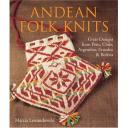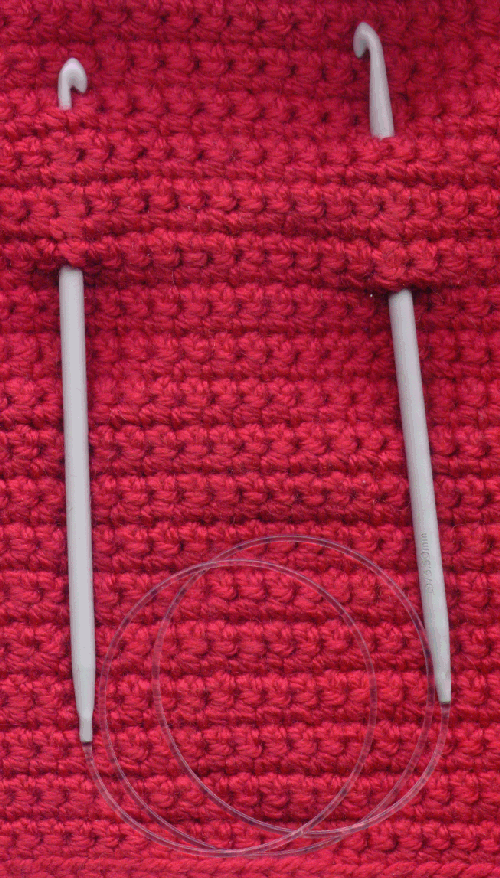Recently Abby wrote about Andean spinning and that reminded me of how often I wished I could ask her Dad, Ed Franquemont about this. He was such a fountain of historical information – usually with good data to back it up.
Well, the last few weeks, it seems I am on something of a tear attempting to find more info about “Portuguese Knitting” which seems to share some technique with the Andean poeples as well.
What I have been able to find “so far”, mostly surmised from YouTube Videos, vagure memories of watching Ed Franquemont showing some “Incan” knitting and pictures in a few books, is that some how yarn is tension either by wearing the skein like a necklace, or using a pin on one’s shoulder. (See the picture of Andrea Wong here
Thus the yarn is between you and the work “most of the time”. And the yarn is manipulated to form the stitches, using your thumb in a seemingly very efficient manner. BTW, if you are a “visual” learner, then you may just find that the YouTubes with the voice over being in Portuguese to be the most helpful/clear.
Although many have suggested Andean & Portuguese are the same, so far only “Portuguese” knitting seems to use crochet hooks and at least one of the more esoteric suppliers of fiber art tools, sells these needles – hook on one end, point on the other in a limited variety of sizes, in sets of four or five per size – suggesting use for in the round type project.
I have been told that

Andrea Wong’s Video is an excellent resource, but unhappily it will not play in any of our machines.
Several have suggested I might find more information in the out of print book, Andean Folk Knitting: Traditions and Techniques from Peru and Bolivia. by Cynthia Gravelle Lecount, ISBN: 0932394078, but so far I have not been able to find an affordable copy and/or library that has it.
I was able to find lots of sources for Marasha Lewandowski’s

Andean Folk Knits: Great Designs…
So Abby, (or anyone else) I’d love to hear from you – Or should I just resign myself, accept I can knit with crochet hooks and will never know the history


Boy, Wheat, I’ll tell you, I also wish I could ask Ed stuff all the time. Some nerve he had dying too soon.
As I have always understood things, knitting as we know it today came to the Iberian peninsula (Spain and Portugal) in the course of contact with the Arabic world. Said contact, starting in the 8th century or so, is responsible for bringing a great deal of technology, science, and luxury to the Western European world; interestingly enough, a lingering evidence of this can be found in the trivia that in Spanish, many words for luxury items start with “al” and are traceable etymologically to Moroccan words.
Here’s a reference:
http://books.google.com/books?id=nMGQnFlYAh0C&pg=PA13&lpg=PA13&dq=arabic+knitting&source=web&ots=zcuI7pn1ux&sig=pAf3bjKPtF0f6PaLyTA3wt4klcc
http://books.google.com/books?id=nMGQnFlYAh0C
The author, James Norbury, states that knitting arrived in Spain from Africa. What I know of really really old knitting in Africa and the Middle East is somewhat limited, but I do understand that today in Turkey, Morocco, Afghanistan, and several other places, you can still find indigenous and rural people knitting with hooked needles such as you describe. As with Andean knitting, yarn is tensioned around the neck or through a pin near your shoulder, and tends to be worked in the round and from the wrong side / the purl side (in other words, the inside of the round object). These techniques often involve the carrying of up to 4 colours simultaneously, locking them into place at each stitch so there are no floats on the inside of the work; the resulting fabric does not have the elasticity of modern European-style knitting, though it is more elastic than most woven fabrics.
The use of a hooked needle would be a boon for working with this set of techniques. I understand that old African needle sets are, as you describe, crochet hook on one end and pointed needle on the other; I have a few such tools from the USA which are old, and I’ve found on ebay and so on, over the years. I treasure them for various reasons. In the Andes, no such tools are used, but I think this is likely partly due to the limited availability of materials from which to make tiny-hooked tools with any degree of durability; options for tools in the Andes are a small amount of softer woods and bone, and the easy to find indigenous metals there are gold and silver, which while pretty, are too soft to make good tools. I personally believe that to be a big reason why textiles are so important to the Andean world; and pre-Columbian metallurgy there is mostly for purposes of art, rather than weapons or tools (unlike in most of the rest of the world’s technological development).
No true knitting, as we define knitting now, is extant in the Andes prior to contact with Spain; it’s probably safe to say that knitting is an old world textile technology, with two major development streams historically (the pan-African, coming from “shepherd’s knitting” and the hooked needles and whatnot, and the Norse/Scandinavian etc coming from naalbinding). In addition to previously mentioned countries where knitting is done in ways similar to those we’re talking about, I’ve heard from folks from Greece and Egypt that they’ve seen, or learned, similar techniques there.
With respect to Andean knitting, the best book addressing the real meat of some of the techniques that I have seen is Donna Druchunas’ recent “Ethnic Knitting Discovery” from Nomad Press.
And, lest you don’t have it, Annie of Annie’s Attic’s book “Living Mystery of Crochet” is pretty darned interesting.
Soooo… did I miss anything?
WOW Thank you so much, MORE Books to track down
AND I LOVED the link that talks about what we are probably calling
Knitting “looms” and Frames.
TheHenry Was Right… I should have asked you first
Wheat
I found your site because of your comment on the spin list and now I’ve spent over an hour looking around. Great blog! Thank you so much. I’ll be back.
Hi, Wheat!
Have you seen the section in “Knitting Around the World” (by Threads magazine) that talks about different knitting traditions around the world? On p. 93 there is a discussion of knitting Greek style with the yarn is tensioned behind the neck and & looped onto the rt. needle with the left thumb. Sound familiar?
On another topic: I personally believe that knitting came to Spain via the Arab world and that the inhabitants of the New World learned knitting from the Spaniards. It would be interesting to compare the knitting styles of Arab knitters with those of Spanish and Latin American knitters. I knit using a method described in Mary Thomas’ book as “Eastern Combined Uncrossed”, which is supposedly used in the Arab world (?) and eastern Europe including the Balkans and Russia. One must always remember that individuals, of course, develop their own little “wrinkles” and not all knitters in a certain geographic area or of a certain ethnic origin knit in the same style. For example, my German friend knits like an American (wrapping the yarn English/American style) while I originally knitted German style. After severaI hand surgeries I changed to Eastern Combined Uncrossed because I saw an article in Interweave Knits in 2000 that said this method is easier on the hands. This is true.
Happy hunting about Portuguese knitting. By the way, Portugal and Spain were the same country until about the 11th century so a lot of things in their culture will probably be the same. Let me know if you find out about the knitting styles of Arab and Spanish knitters and how they compare to the styles of Latin American knitters.
I am a retired Spanish teacher and I taught Spanish history, geography, and culture for many years.
Hi. Are you still interested in what you posted way back in this blog entry about Portugese vs. Andean Knitting?
I can dig up a bit perhaps about the hooked needles, but I wanted to let you know that there is no information in that depth in Cynthia LeCount’s book. Unless I have missed something, and I searched the book through several times, this is the only place I find allusion to this topic (under “P” in the index, there is no entry for ‘purl’ only ‘purses’):
P. 78. of “Andean Folk Knitting”.
“Andean knitters in some areas use the weaving technique [vs stranding] just described, but work from the INSIDE, purling al stitches and draping the yarns around their necks to get the proper tension. This traditional method is fun to try. The fact that I can’t see what I’m doing on the right side bothers me, but the tension is perfectly regulated by the ‘drag’ of the yarn around the neck.”
Thank you for the added info. Some day we may really get an answer as to why they make the “hook-point” needles, but for now, if nothing else they are great for free from ass long as you don’t need full range of sizes.
I came across this series of blog posts while gathering information to put together about the different ways of knitting across the world. There’s some really great information here and I continue to look for more information concerning geographic and cultural variations in knitting.
Anyhow, I wanted to leave a comment with a link to a youtube video that I think shows what knitting needles with hooks on them are used for:
http://www.youtube.com/watch?v=PjkctMs9w90
In this video it’s called Russian knitting but a few other comments around the Internet suggest that other European knitters use these sort of needles as well. Essentially, the hook is put on the end of the needle to make it easier to purl while knitting Continental style.
Both of my father’s parents were Portugese. My grandmother taught me to knit (throwing). It’s my special bond that I have with her now that she’s gone that I always think of her when I knit. I am determined to learn how to Portuguese Knit. However I am having difficulty finding “the pin”. So I looked on line and found several posts… some mentioned using magnets, some putting the pin on a necklace. I am ready to begin making some pins of various kinds. My only problem is that I can NOT find the “J hook” for the yarn to slide through. I’ve tried looking under beading etc and I’m having no luck at all. Thanks bunches, Sue
Thank you for sharing your story. It is wonderful when we have “moments like these” to enrich our lives.
Although we do sell Andrea Wong’s pin,
http://itsalljuststring.com/yarn-accessories-notions-90/all-yarn-notions-91/portuguese-knitting-pin-by-andrea-wong-352240005.html
it would be great to see what you are doing. We have some great finding connections, it may be that one of my suppliers has what you need even if not yet in the ItsAllJustString.com catalog.
Hi, I have found a pattern I’d love to make but she uses size 6 thread on a cone, what size would it be in America? We don’t have that size here. Thank you